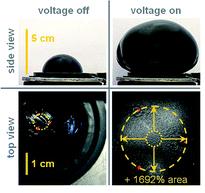 What does softness do for life? According to Zhigang Suo, Havard University, for life the important feature of soft materials is that they are easily deformable. In the human body the deformation of soft materials enables the heart to beat, the vocal folds to produce sound and the eye to focus. In all these examples, a stimulus is applied to the soft material and a large reversible deformation occurs. This deformation in turns provides a function.
What does softness do for life? According to Zhigang Suo, Havard University, for life the important feature of soft materials is that they are easily deformable. In the human body the deformation of soft materials enables the heart to beat, the vocal folds to produce sound and the eye to focus. In all these examples, a stimulus is applied to the soft material and a large reversible deformation occurs. This deformation in turns provides a function.
Soft active materials are not only important in life, but also have technological relevance for example in adaptive optics, self-regulated fluidics and soft robotics. Suo is interested in how mechanics, chemistry and electrostatics all work together to generate large deformations in soft materials. In soft dielectrics actuation can be readily observed by applying a voltage across the membrane, causing the thickness to reduce and the area to expand. In polymers, strains of up to 30% are easily achieved using this method.
To get higher deformations two limitations need to be overcome; electrical breakdown and electromechanical instability. An electromechanical instability is observed in compliant dielectrics such as elastomers, when the applied voltage causes the material to thin down excessively, amplifying the electric field. This is known as a snap-though instability and often occurs prior to electrical breakdown. Suo has shown, however, that if this electromechanical instability can be overcome, and the elastomer reaches a stable state without breakdown occurring, giant voltage-induced deformations of over 1000% are achievable.
Suo’s theory shows that the instability can be eliminated when pre-stretched or short-chain polymers, where the elastic strain is sufficiently low, are used. The elastomer is compliant at low deformations and stiffens rapidly as it is slowly stretched. This stiffening averts the rapid excessive deformation that would otherwise cause the material to fail. The elastomer survives the instability and reaches a steady state without breakdown occurring. Suo and his collaborators have used these ideas to carefully design and tailor the properties of soft materials realising area expansions of 1692%.
For more information see:
Keplinger et al., Harnessing snap-through instability in soft dielectrics to achieve giant voltage-triggered deformation, Soft Matter, 8, 285-288, 2012.
Lu et al., Dielectric elastomer actuators under equal-biaxial forces, uniaxial forces, and uniaxial constraint of stiff fibers, Soft Matter, 8, 6167-6173, 2012.
Zhao and Suo, Theory of Dielectric Elastomers Capable of Giant Deformation of Actuation, Phys. Rev. Lett., 104, 178302, 2010.










